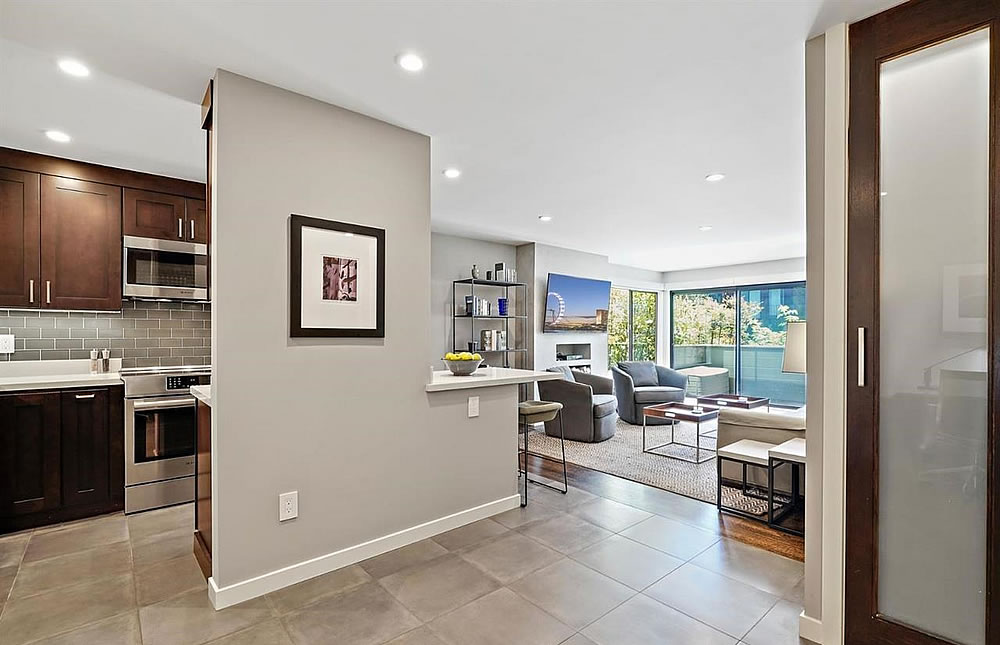Purchased for $495,000 in January of 2020, the Below Market Rate (BMR) unit #101A at 45 Ora Way, a 684-square-foot, one bedroom condo that was remodeled in 2015, returned to the market priced at $499,000 last month, a lottery for which was scheduled to be held this week.
With zero (0) applications to purchase the unit for $499,000 having been received, however, the list price for the unit, which comes with a deeded parking space and access to the development’s pool, spa, gym and grounds near the Diamond Heights Shopping Center, has just been reduced to $465,000 and the unit will now be “available on a first come first served basis starting on 05/10/2024 at 8:00 AM PST.”
Keep in mind that restrictions for buyers do apply, with household incomes limited to 120 percent of the Area Median Income (AMI), which currently translates to a maximum income of $125,900 for an individual, $143,900 for a couple and $161,800 for a family of three, and buyers can not have owned another home within the past three years.








How does buying a BMR property ever make sense? The program seems designed to ensure that buyers can just barely afford the unit, with income limits that narrowly align with the loan requirements. I’ve crunched the numbers, and the 3% minimum down payment often makes these loans barely affordable for those who qualify under the income limits. It appears the expectation is for buyers to have 25-30% to put down. How realistic is this in areas where low- to middle-income residents can hardly save money after covering living expenses?
Moreover, it seems you’re barred from making any improvements for 10 years. You can’t sell the property at a profit, yet selling at a loss is possible. Who does this actually help?
BMR owner here – you do generally have to fall just under the income requirements to be able to meet the monthly mortgage, and you can make improvements immediately (my unit had no flooring when I bought it). With interest rates low, this was typically OK, but I have no idea what’s happening now. The pricing is also all over the place – there are units that are larger than this but significantly cheaper (because the building is older) and even smaller units priced about this high. When I purchased in 2017, it seemed like the BMR prices were set at about 30-40% of market rate units in the same building. Now it seems like they are being priced closer to 50-60%, which is also a weird shift that lowers demand (a BMR at $500K isn’t that much below the lowest-end downtown condos right now.) Drop the price and more people will line up to buy.
I don’t know if the “You can’t sell the property at a profit, yet selling at a loss is possible” assertion is correct. My understanding, as someone who hasn’t yet purchased a BMR property, is that you can sell the property at a profit, but the profit level is limited. This property sold in the third quarter of 1999 for less than $180k.
You’re correct that the BMR program doesn’t help everyone, and certainly not the ones who need help the most. But it does help some buyers. That is better than doing nothing.
The people it actually helps are those who are not among the flippers, penny ante mom and pop “developers”, and other hangers-on who have arrived here from elsewhere to make their fortune in the S.F. real estate “game”. Those who want a place to live without having to fight to stay in a rent-controlled unit, and also don’t want to have their life decisions be subject to the whims of the merciless (market-rate) landlord class here.
Yeah I think most BMR owners do sell at a profit if they stay in the unit more than a couple years. In this case it was bought in 2020 (possibly peak of the last market) and they are selling in a rough bottom point. Most owners won’t have this issue.
Very true indeed. These people trying to sell these properties have no clues. On top of that one has to pay exhorbitant monthly condo fees. That’s just ridiculous! Even if the property was $300,000 it just does not make any sense!
Yes, the BMR program has yielded mixed results. When offered up in a brand-new building people line up around the block to view the units and gain a lottery ticket hoping to win. But resale units often languish to find a buyer for some reason. The HOA fees can be a deciding factor too, as they are not calibrated in sync with the BMR pricing – they are market rate. ($788 per month for this unit)
Just to add context, the HOA fees are not a function of the market, they are a function of the hard costs (insurance, maintenance and upkeep, replacement reserves, etc.) and so of course BMR owners’ HOA fees are the same as any other owners’ fees, adjusted for unit size, etc.
So it doesn’t really make sense to refer to “market rate HOA fees.” HOA fees for a property are not something that can be adjusted down for one unit without adjusting all the other units up to compensate, which wouldn’t be at all fair.
That’s not totally true, both that HOA can’t be adjusted and that it wouldn’t be fair. I know for sure of at least one luxe downtown high-rise whose HOA dues are lower for BMR units. Though I think they may not have full access to all the on-site amenities (and I believe it required special negotiation with the city and was approved through the former redevelopment agency; everyone — both developer and city were on-board with this approach). Therein lies the rub. Some buildings/developments have extensive amenities (eg pools, gyms, concierges, etc) that are extras not necessary to just having a home and keeping a roof over your head. Most housing doesn’t come with pools and gyms and valets and other stuff like that. While from an initial construction cost those things aren’t big ticket items (or aren’t even capital costs), operationally they are not insignificant. The problem lies when BMR units are lumped in with luxe units that come with all this frivolous stuff that BMR owners wouldn’t pay for if they had the choice. So, yes it would be very fair to adjust HOA dues.
I don’t think ‘NA’ is saying that every unit has to pay the same HOA, only that they can’t be randomly changed just to sell a unit (so BMR unit might have dues of half of MR units, but that can’t just be cut to a third…just to move it; it’s an obligation, so the (hoping to soon be ex) owner can’t just waive it.
Exactly. And most of the costs that go into HOA dues are hard costs like fire insurance and reserves for a new roof and a paint job when needed, and those costs are typically spread across all owners based on the proportion of total square footage they own. It would not be fair, nor would it likely be acceptable to other owners, to say “BMR owners don’t have to pay their fair share of building expenses, the rest of us will pay extra so they can pay less.”
Yes, in buildings with lots of pricey amenities, you might be able to craft lower dues for BMR units and not charge them of (or give them access to) certain amenities, like a swimming pool, and perhaps some would be okay with that… but to me, that creates an awkward division between residents, much like the “poor door” system they use in NYC. Of course, residents often know which units are the BMR units so I suppose a bit of stigmatizing may already occur in some properties. But most SF buildings don’t have easily-excludable amenities and so most of the time, the dues really can’t be any different for BMR and market rate units.
In other words, what the market costs are for those services? (insurance, maintenance and upkeep, replacement reserves, etc.)
Some data context would be helpful regarding the typical time needed to sell a Below-Market-Rate home.
My own clicking-around experience suggests that the very thin buyer pool makes a sale process that is usually 2x to 3x longer than a typical market transaction.
This seems like a normal outcome, especially in the face of much higher interest rates.
Yes, if a potential buyer requires a quick resale once they decide to re-sell the property, then the BMR program isn’t for them. This program should be to help people who want to live in S.F. to acquire housing they can afford, not for fleeting cosmopolitan globalists who want to trade properties like Magic: The Gathering cards.
Right on the Mayor’s Office of Housing and Community Development’s website, on the page entitled https://www.sf.gov/resell-your-below-market-rate-bmr-home (where it also says explicitly that MOHCD determines pricing for BMR resales), the third bullet point at the top of the page says: Selling your home will take about 4 and 6 months..
There are “regular” condos at that same price-point, $499,000 available in that same complex and there was also a recent sale of a 1bed/1bath 744 SqFT patio unit in Diamond Heights Village. Why anyone would go the BMR route seems counter-intuitive in this market. This happened in 2008-2010 when condo prices also tanked. With half of all office space currently vacant, condo prices will remain well off their 2015 highs.
The other main problem with the BMR program is that the Trump tax plan, which doubled the standard deduction, has made BMRs less attractive from a tax position. That the City gets to decide where a BMR seller can set their price point is another. And yes HOA fees have gone through the roof, especially in older buildings with deferred maintenance where the residents chose personal greed over funding their HOA.